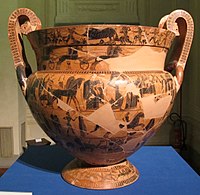National Archaeological Museum, Florence
Museo archeologico nazionale di Firenze | |
 | |
 | |
| Location | Piazza Santissima Annunziata 9 B, Florence, Tuscany, Italy |
|---|---|
| Coordinates | 43°46′34.46″N 11°15′44.16″E / 43.7762389°N 11.2622667°E |
| Type | Archaeology |
| Website | Official website |

The National Archaeological Museum of Florence (Italian – Museo archeologico nazionale di Firenze) is an archaeological museum in
History
The museum was inaugurated in the presence of king
The collection's first foundations were the family collections of the Medici and Lorraine, with several transfers from the
Etruscan collections

The organisation of the Etruscan rooms was reconsidered and reordered in 2006. Also in 2006, the 40-year-overdue restoration was carried out on over 2000 objects damaged in the 1966 floods.
- The Chimera of Arezzo – discovered in 1553 at Arezzo during the construction of a Medici fortress
- The statue of the (1st century BC)
- The funerary statue Mater Matuta (460–450 BC) (returned to Chianciano Terme)
- The sarcophagus of Laerthia Seianti (2nd century BC)
- The sarcophagus of the Amazons (4th century BC)
Roman collections
- The "idolino of Pesaro", a 146-cm-high bronze statue of a young man, a Roman copy from a classical Greek original, found in fragments in the centre of Pesaro in October 1530.
- The "torso di Livorno", copy of a 5th-century BC Greek original.
- Statue of a cockerel, the so-called "Gallo Treboniano", late 3rd-century work.
- The Minerva of Arezzo, a bronze Roman copy of a 4th-century BC Greek model attributed to Praxiteles.
Greek collections
The huge collection of ancient ceramics is shown in a large room with numerous cases on the second floor. Generally the vases come from Etruscan tombs and are evidence of cultural and mercantile exchange with Greece, and particularly Athens (where most of the vases were made) and date to the period between the 4th century BC and the present.
The most important of the vases is a large
- the red figure hydriasigned by the Meidias painter (550–540 BC)
- the cups by the Little Masters (560–540 BC), named after their miniaturist style of their figures
- the sculptures of Apollo and Apollino Milani (6th century BC, named after the man who gave them to the museum)
- the athlete's torso (5th century BC)
- the large .
- two Archaic marble kouroi, displayed in a corridor
-
The "Vase Francois"
-
The "Apollino Milani"
-
Gallery in the Egyptian collection
Egyptian Museum
The Egyptian section of the collection is known as the Egyptian Museum, and is the second largest collection of Egyptian artifacts in Italy, after that of the Museo Egizio in Turin.
Foundation
Florence's first collection of
Development
The museum was officially opened in 1855. The first director was Ernesto Schiaparelli, from Piedmont. He later went on to become director of the larger Egyptian museum in Turin. By 1880 he had catalogued the collection and organized transportation of the antiquities to the Florentine Archaeological Museum. Under Schiaparelli, the collection expanded with further excavations and purchases carried out in Egypt. Many of the artifacts were, however, later transferred to Turin.
The Florentine collection continued to grow after this time, with donations from private individuals and scientific institutions. In particular, the Papyrological Institute of Florence provided artifacts from its expeditions to Egypt between 1934 and 1939. These now provide one of the most substantial collections of Coptic art and documents in the world.
The Egyptian Museum today
The museum now has a permanent staff including two professional Egyptologists. It houses more than 14,000 artifacts, distributed in nine galleries and two warehouses. The artifacts displayed in the galleries have been substantially restored. The old classification system devised by Schiaparelli is being replaced by a new, chronological and partly topographical system.
The collection comprises material that extends from the prehistorical era right through to the Coptic Age. There are remarkable collections of
) and many other distinctive artifacts from many periods.-
Royal sarcophagus
-
Woman's sarcophagus
-
Portrait fromAl Fayyum
-
Ptolemaicsacred stele
-
Egyptianfunerary mask
Separate section
A separate section of the museum is in the baroque Villa Corsini a Castello, nearby Florence, mostly dedicated to Ancient Roman and Etruscan sculpture.
See also
References
- ^ W. Decker: "Wagen", in: W. Helck; W. Westendorf: Lexikon der Ägyptologie, Band VI, Wiesbaden, 1986, Sp. 1131.









